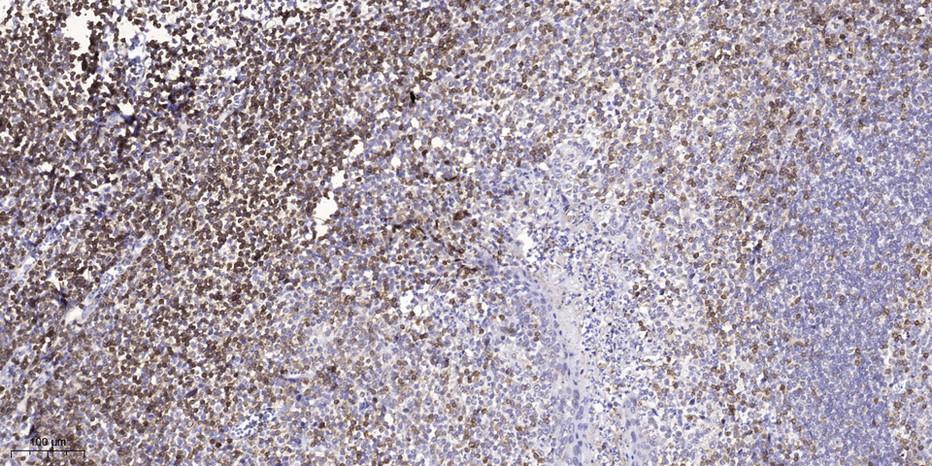Stonin-1 Polyclonal Antibody
- Catalog No.:YT4463
- Applications:WB;IHC;IF;ELISA
- Reactivity:Human;Mouse
- Target:
- Stonin-1
- Gene Name:
- STON1
- Protein Name:
- Stonin-1
- Human Gene Id:
- 11037
- Human Swiss Prot No:
- Q9Y6Q2
- Mouse Swiss Prot No:
- Q8CDJ8
- Immunogen:
- The antiserum was produced against synthesized peptide derived from human STON1. AA range:686-735
- Specificity:
- Stonin-1 Polyclonal Antibody detects endogenous levels of Stonin-1 protein.
- Formulation:
- Liquid in PBS containing 50% glycerol, 0.5% BSA and 0.02% sodium azide.
- Source:
- Polyclonal, Rabbit,IgG
- Dilution:
- WB 1:500 - 1:2000. IHC 1:100 - 1:300. IF 1:200 - 1:1000. ELISA: 1:10000. Not yet tested in other applications.
- Purification:
- The antibody was affinity-purified from rabbit antiserum by affinity-chromatography using epitope-specific immunogen.
- Concentration:
- 1 mg/ml
- Storage Stability:
- -15°C to -25°C/1 year(Do not lower than -25°C)
- Other Name:
- STON1;SALF;SBLF;STN1;Stonin-1;Stoned B-like factor
- Observed Band(KD):
- 83kD
- Background:
- stonin 1(STON1) Homo sapiens Endocytosis of cell surface proteins is mediated by a complex molecular machinery that assembles on the inner surface of the plasma membrane. This gene encodes one of two human homologs of the Drosophila melanogaster stoned B protein. This protein is related to components of the endocytic machinery and exhibits a modular structure consisting of an N-terminal proline-rich domain, a central region of homology specific to the human stoned B-like proteins, and a C-terminal region homologous to the mu subunits of adaptor protein (AP) complexes. Read-through transcription of this gene into the neighboring downstream gene, which encodes TFIIA-alpha/beta-like factor, generates a transcript (SALF), which encodes a fusion protein comprised of sequence sharing identity with each individual gene product. Alternative splicing results in multiple transcript variants. [provided by RefSeq, Oct 2010],
- Function:
- caution:The sequence shown here is derived from an Ensembl automatic analysis pipeline and should be considered as preliminary data.,function:May be involved in the endocytic machinery.,function:May function as a testis specific transcription factor. Binds DNA in conjunction with GTF2A2 and TBP (the TATA-binding protein) and together with GTF2A2, allows mRNA transcription.,miscellaneous:In contrast to other members of the family, it does not contain NPF (Asn-Pro-Phe) sites and thereby does not interact with EPS15, EPS15R and ITSN1.,sequence caution:Chimeric cDNA. The biological existence and relevance of this product of both SALF (AC Q9Y6Q2) and GTF2A1LF genes, creating a chimeric protein of 1182 residues is uncertain.,sequence caution:Chimeric cDNA. The biological existence and relevance of this product of both SALF and GTF2A1LF (AC Q9UNN4) genes, which codes for a chimeric protein of 1
- Subcellular Location:
- Cytoplasm . Membrane . Some fraction is membrane-associated.
- Expression:
- Ubiquitous.
- June 19-2018
- WESTERN IMMUNOBLOTTING PROTOCOL
- June 19-2018
- IMMUNOHISTOCHEMISTRY-PARAFFIN PROTOCOL
- June 19-2018
- IMMUNOFLUORESCENCE PROTOCOL
- September 08-2020
- FLOW-CYTOMEYRT-PROTOCOL
- May 20-2022
- Cell-Based ELISA│解您多样本WB检测之困扰
- July 13-2018
- CELL-BASED-ELISA-PROTOCOL-FOR-ACETYL-PROTEIN
- July 13-2018
- CELL-BASED-ELISA-PROTOCOL-FOR-PHOSPHO-PROTEIN
- July 13-2018
- Antibody-FAQs
- Products Images

- Western Blot analysis of K562 cells using Stonin-1 Polyclonal Antibody

- Western blot analysis of lysates from K562 cells, using STON1 Antibody. The lane on the right is blocked with the synthesized peptide.

- Immunohistochemical analysis of paraffin-embedded human tonsil. 1, Tris-EDTA,pH9.0 was used for antigen retrieval. 2 Antibody was diluted at 1:200(4° overnight.3,Secondary antibody was diluted at 1:200(room temperature, 45min).



